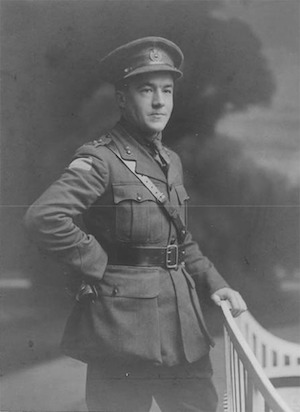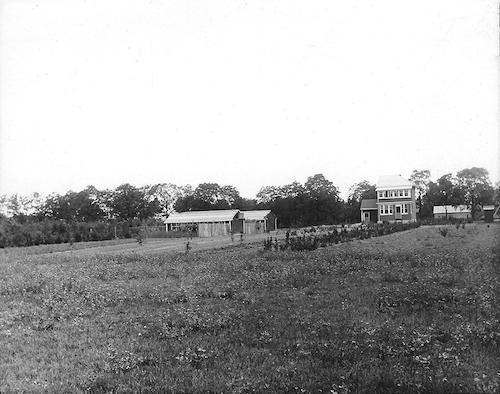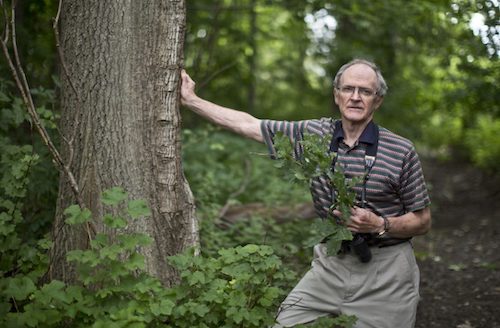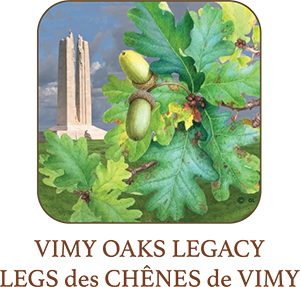Canada’s “Vimy Oaks” Soldier
Lieutenant Leslie H. Miller, a soldier with the Canadian Expeditionary Force (1914-1919), sent acorns home to Canada that he had gathered after the Battle of Vimy Ridge in April 1917.
These acorns are now large majestic oaks that are growing on his former farm, today the home of the Scarborough Chinese Baptist Church, in Scarborough Ontario.
‘World War One’ wiped out all but one native oak known to survive in the area today. The foresight of Lieutenant Miller allows us the possibility to repatriate young “Vimy Oak” saplings to their original territory of Vimy Ridge one hundred years later.
Leslie Miller was born October 5, 1889 on the family farm in Scarborough, Ontario. His Canadian family was of German origin. They immigrated to the United States of America around 1740. In 1792, while the family lived in Philadelphia, Pennsylvania, Nicholas Miller, Leslie Miller’s great-great-grandfather, was invited by Lieutenant Governor John Graves Simcoe to come to Upper Canada (present day Ontario) to build the government’s first industrial facility – a sawmill – on the Humber River (today known as “The Old Mill”). It was completed in 1793, assisted by the Queen’s Rangers. Over the years, the Miller family descendants have contributed to the foundation of Canadian society in the fields of industry, business and politics.


Leslie Miller was a learned man who loved people, nature and languages (French, German, Spanish, Greek, Hebrew and English). His goal was to be a teacher. Following his studies at the University of Toronto he moved to Saskatchewan to teach. While there in October 1914, he enlisted as a private in the 24th Border Horse of Weyburn, Saskatchewan. He subsequently joined the Signal Corps and was assigned to the 5th Battalion to go overseas. The severe winter of 1915 delayed his arrival at Shorncliffe army camp in England until April. There, he underwent six months of intensive signals training before crossing the Channel to Le Havre, France, in October 1915. He entered the line on the France - Belgium frontier just south of Messines.
Leslie Miller spent most of his war years in the Nord-Pas de Calais region of France. He rose through the ranks and received a field commission as 1st Lieutenant in 1918. In the Signal Corps, he mastered the means of communication (semaphore, Morse code, even pigeons) and trained other soldiers in these same skills. He deployed wireless technology and the newly developed line based Morse Fullerphones that were immune from overhearing by the enemy. He established communication networks and listening stations traversing the battlefields at night using his knowledge of astronomy to guide him. His mastery of languages was particularly important in his intercepts and interpretation of German wireless messages for which he received commendations.
Although present at many of the horrifying battles of World War One, Leslie Miller’s war diary is largely devoted to the friendships he cultivated with local French families, his fellow soldiers, his interaction with German prisoners and the nature he discovered around him.
Upon returning to Canada, for health reasons, Lieutenant Miller was unable to resume his teaching career. His father gave him 24 acres of the family farm where his “Vimy Oaks” were growing. He replanted the oaks as part of his woodlot that also included sugar maples, black walnut and other hardwoods. Leslie named his land “The Vimy Oaks”. While working his fruit and vegetable farm he used his skill in languages to reach out to new Canadians, giving them garden plots to grow their own produce. He also mentored many young people whom he employed part time on his farm, passing on his values and his love of nature and the humanities.
Ten of the original oaks soar into the sky today. Descendants of these great symbolic trees were repatriated to Vimy Ridge in November 2018 to create living memorials to honour those who fought in the Great War, connecting modern Canada and modern France and reaffirming our comradeship with France and her people.

